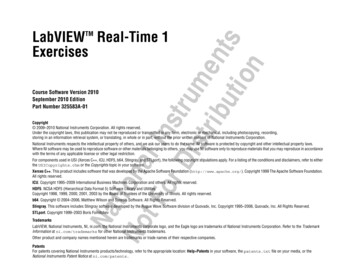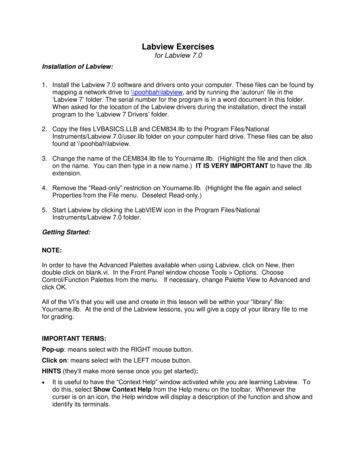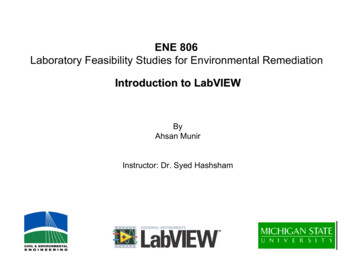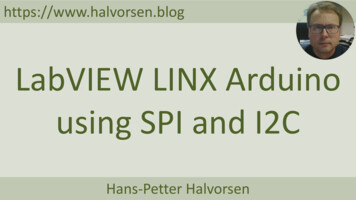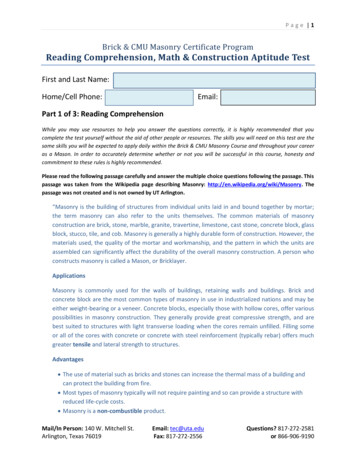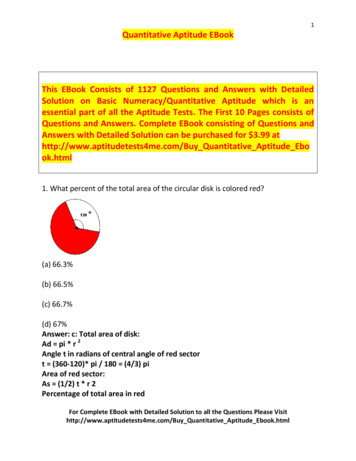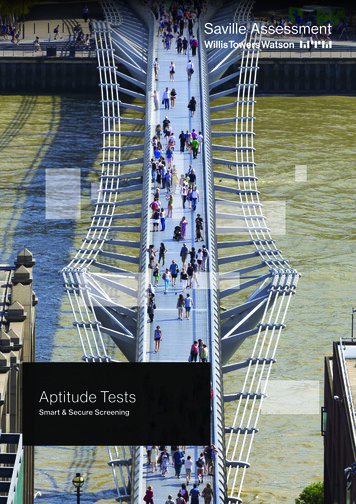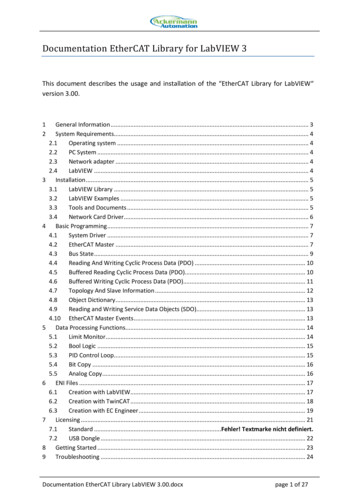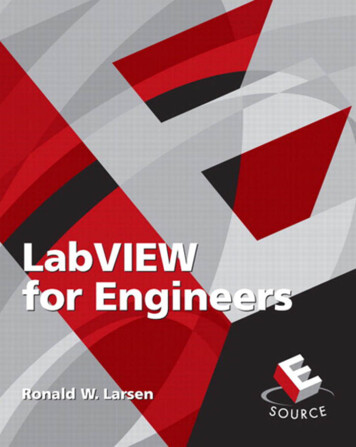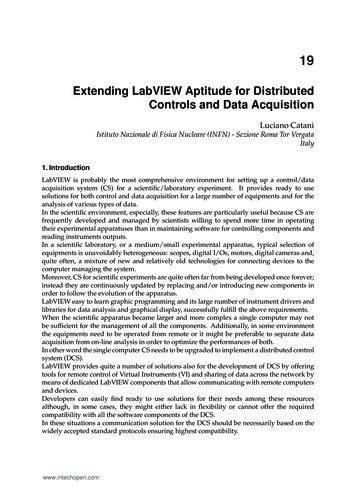
Transcription
019Extending LabVIEW Aptitude for DistributedControls and Data AcquisitionLuciano CataniIstituto Nazionale di Fisica Nucleare (INFN) - Sezione Roma Tor VergataItaly1. IntroductionLabVIEW is probably the most comprehensive environment for setting up a control/dataacquisition system (CS) for a scientific/laboratory experiment. It provides ready to usesolutions for both control and data acquisition for a large number of equipments and for theanalysis of various types of data.In the scientific environment, especially, these features are particularly useful because CS arefrequently developed and managed by scientists willing to spend more time in operatingtheir experimental apparatuses than in maintaining software for controlling components andreading instruments outputs.In a scientific laboratory, or a medium/small experimental apparatus, typical selection ofequipments is unavoidably heterogeneous: scopes, digital I/Os, motors, digital cameras and,quite often, a mixture of new and relatively old technologies for connecting devices to thecomputer managing the system.Moreover, CS for scientific experiments are quite often far from being developed once forever;instead they are continuously updated by replacing and/or introducing new components inorder to follow the evolution of the apparatus.LabVIEW easy to learn graphic programming and its large number of instrument drivers andlibraries for data analysis and graphical display, successfully fulfill the above requirements.When the scientific apparatus became larger and more complex a single computer may notbe sufficient for the management of all the components. Additionally, in some environmentthe equipments need to be operated from remote or it might be preferable to separate dataacquisition from on-line analysis in order to optimize the performances of both.In other word the single computer CS needs to be upgraded to implement a distributed controlsystem (DCS).LabVIEW provides quite a number of solutions also for the development of DCS by offeringtools for remote control of Virtual Instruments (VI) and sharing of data across the network bymeans of dedicated LabVIEW components that allow communicating with remote computersand devices.Developers can easily find ready to use solutions for their needs among these resourcesalthough, in some cases, they might either lack in flexibility or cannot offer the requiredcompatibility with all the software components of the DCS.In these situations a communication solution for the DCS should be necessarily based on thewidely accepted standard protocols ensuring highest compatibility.www.intechopen.com
4002Practical Applications and Solutions Using LabVIEW SoftwareWill-be-set-by-IN-TECHThere exist numerous possible alternatives. One such model is Microsoft’s componentobject model COM(mscom, 2011) and its associated distributed component object modelDCOM which allows COM objects to run and communicate in a distributed manner. Alsofrom Microsoft is the .NET environment, supporting Internet-based connectivity betweencomponents.Another option is offered by the CORBA(corba, 2008) proposed by the Object ManagementGroup (OMG). CORBA is a software standard for component-based development that hasbeen quite successful among developers of DCS.Yet another model is the Java-based proposal by Sun Microsystems, which encompasses basicinfrastructure such as Java Beans and Enterprise Java Beans and remote method invocation(RMI) but also more ambitious solutions for interoperation of distributed intelligent systemssuch as Jini(jini, 2006).The aim of this paper is to present the development of a communication framework fordistributed control and data acquisition systems, optimized for its application to LabVIEWdistributed controls, but also open and compatible with other programming languagesbecause it is based on standard communication protocols and standard data serializationmethods. In the next Paragraph the LabVIEW tools for Distributed Systems and their fieldof application will be briefly presented. In Paragraph 3 the general purpose communicationframework will be discussed, with particular attention to the problem of data serializationand the definition of the communication protocol. Paragraph 4 and subsequents will discussin details the implementation of the communication framework in LabVIEW, focusing on thedevelopment strategies and the solutions for achieving the performances required for thisfield of application.2. LabVIEW tools for distributed systemsLabVIEW offers a number of tools for transferring, via network, data between the componentsof a distributed control/data acquisition system.The Table 1 shows some solutions provided built-in by LabVIEW, a subset of the networkingfeatures suggested by National Instruments for developing distributed control systems (Limaet al., 2004). Common to all these solutions is the ease of implementation because they havebeen designed to require very limited programming effort.Shared Network Variable, DataSocket, VI Server, VI reference, TCP/IP and UDPcommunication libraries and also interfaces to .NET and ActiveX are the main communicationtools offered by LabVIEW. They are powerful and well suited for many applications but, withthe exception of TCP/IP and UDP, are not flexible enough to allow the implementation of areal communication protocol.Shared Variable and Data Socket, for instance, basically provide data sharing across thenetwork, others (VI Server, VI reference) allow access to remote VI, with some relevantrestrictions in some cases, and their use is limited to LabVIEW environment.In addition the LabVIEV Internet Toolkit includes a HTTP server and the possibility to operatethe VIs (Virtual Instruments, i.e. the LabVIEW applications or subroutines) as CGIs that aclient can invoke using the HTTP protocol to execute particular procedure on the server side.This is a relatively flexible solution but offers low performances and limited features.In conclusion it’s hard to find the best candidate for developing an open, general purposecommunication framework because the before mentioned solutions are either offering limitedfeatures or performance, or they are proprietary so that, for instance, integration with thecontrol system of a nearby experiment or with a bigger apparatus, that could have beenwww.intechopen.com
ding LabVIEWAptitude for DistributedControlsData Acquisition Controls and Data AcquisitionUse ed NetworkVariableShare live data with otherVIs on a remote computer,or deployed to a target.NoMany-toManyLowHighDataSocketShare live data with otherVIs on a remote computer,or deployed to a target.YesMany-toManyLowHighApplicationControl VIs andFunctionsProgrammatically controlVIs and LabVIEWapplications across anetwork by way of theTCP protocol and VIServer.YesOne-tooneMediumMediumRemote FrontPanels on theLabVIEW WebServerView and control a VIfront panel remotely usingLabVIEW or a Webbrowser.NoOne-toManyMediumLowWeb Services onthe ApplicationWeb ServerDeploy LabVIEWapplications as Webservices.NoMany-toManyMediumLowHTTP Client VIsBuild a Web client thatinteracts with servers,Web pages, and Webservices.YesOne-toManyMediumLowTCP VIs andFunctionsCommunicate with aninstrument that uses aprotocol based on TCP.YesOne-toOneMediumHighUDP VIs andFunctionsCommunicate with asoftware package that usesa protocol based on ion TransferDelayRateTable 1. LabVIEW most relevant communication features (excertp from CommunicationFeatures table from LabVIEW on-line manual).developed with different software solutions, would be hard to manage or even impossible.On the other side, an example of requirements for the communication framework is givenby the list of communication modes it should allow, like for instance the four cases shown inFig.1.The case 1 is the typical client/server model: a client application asks for data to a remotecontroller and receives from it the required information that could be, for instance, the mostrecent value of an I/O channel, the history of that value, a bundle of data of different types.The case 2 is similar to the remote procedure call (RPC) model: a client application needsto execute a subroutine or procedure on a device attached to another controller without theprogrammer explicitly coding the details for this remote interaction. It could be the change inthe set point of a remote equipment, the execution of a measurement. etc.For the above mentioned modes of communication a programmer can relay on thepredictability of type of data handled and on the limited set of action to be taken on the serverand client side. It that would have been the case, DataSocket or VI Server will probably solvewww.intechopen.com
4024Practical Applications and Solutions Using LabVIEW SoftwareWill-be-set-by-IN-TECHmiddle layerClient App 1read cmdSrv App 1case 1Client App 1Client App 1dataSrv App 1set cmdSrv App 1case 2Client App 1Client App 1OKSrv App 1set cmdSrv App 1case 3Client App 2set cmdSrv App 1Client App 1 stream cmdSrv App 1streamClient App 2 datacase 4Srv App 1Fig. 1. Modalities of interaction between components of DCS to be supported by thecommunication framework.the communication problem.The case 3 and the following case 4 introduce a more elaborated way of interaction. In the firstone a request originated from a client application in turn requires an execution of a commandon the client side according to the response received by the remote unit. The case 4 extends theexample in case 1 to another modality of communication that is a continuous stream of datafrom a server application upon request from the client.These are just few examples but they are sufficient to confirm and strengthen the requirementfor a communication framework that should be based on a versatile and well establishedcommunication solutions, to achieve high compatibility and, at the same time, it should allowinformation to be transferred as different format, i.e. requests or commands, responses anddata of different type.3. A general purpose communication frameworkWhen compatibility and flexibility is an issue, TCP/IP and UDP socket communication mightbe the natural choice. Network socket communication libraries are available for all mainprogramming languages and the simplicity of the protocol ensures a wide compatibility.Indeed, LabVIEW provides tools for interfacing with other devices on a TCP and UDPnetwork with standard socket communication protocol by means of TCP/IP and UDP VI andfunctions.www.intechopen.com
ExtendingLabVIEWAptitudeforandDistributedExtending LabVIEWAptitude for DistributedControlsData Acquisition Controls and Data Acquisition4035The set of functions LabVIEW provides for TCP/IP and UDP communications, similarly toother implementations of network socket libraries, supports few elementary operation: open,close, listen, read and write.The first three are used to establish connections between client and server, the last two fortransferring data in the form of buffers of given length (VI in the Networking/TCP&UDPsection of LabVIEW examples show some possible implementations of network socketcommunication).If data to be transferred is not as simple as either a string of characters or an array of bytes, thecommunication framework should be equipped with tools for packaging and parsing data,regardless their type, size and complexity.This process, known as serialization, converts any complex data structure into series ofbits that can be easily transmitted across a network connection link and later restored inthe original or equivalent form. This result is achieved by adding some kind of descriptor(meta-data) to the payload. Hopefully, the impact of meta-data on the size of serialized datastructure and the coding/parsing execution time on the overall data throughput should belimited.Different types of serialization strategies can be used to flatten object(s) into a one-dimensionalstream of bits suited for their transmission by means of socket communication functions.XML (xml, 2000) (eXtensible Markup Language) is a popular way of coding data especiallywhen interoperability and compatibility between platforms and programming languages isan issue. Client/server communication protocols based on this coding exist, among these themore interesting are SOAP(soap, 2007) and XML-RPC(xmlrpc, 1999). The latter it’s basically aremote procedure call(rpc, 1988) that uses HTTP, or other TCP/IP and UDP protocols, as thetransport and XML to serialize data allowing complex, and relatively large, data structures tobe transmitted and then un-marshaled at destination.Services provided by the server are called methods that a client can invoke by issuing methodCall to the server. The latter, in turn, replies sending the result in the form of methodResponse. Fig.2 shows an example of messages passed between a client and a server in theXML-RPC protocol. They include header with declarations and methodCall or methodResponse fields.The methodCall contains, enclosed with the correspondent tags, the name of the methodto be executed on the server side (methodName) and optional parameters (params). ThemethodResponse, being the reply message from the server to the client contains, enclosedby the (params) tag, the data produce by the execution of the methodName.XML-RPC can be easily implemented in LabVIEW by using the before mentioned socketcommunication libraries; it will be discussed in details in the following Paragraphs.Socket communication sessions are defined upon the couple IP address and port number thatare chosen, on the local and remote computer, for that particular session. That means ina distributed control system with several computers the local application willing to send acommand or receive data to/from another application running on a remote computer shouldbe informed on the IP address and the port number that is used by the remote applicationfor listening incoming connections, or equipped with instruments permitting to obtain thisinformation from some kind of repository.Actually, from the client application point of view, i.e. display consoles, measurementapplication etc. the DCS should better be seen as a distributed set of components: actuators,diagnostic components, equipments etc. and client applications could be unaware of theirphysical location or the details of the communication protocol.www.intechopen.com
4046Practical Applications and Solutions Using LabVIEW SoftwareWill-be-set-by-IN-TECH12POST / HTTP/1.1User-Agent: LabVIEW (XMLvRPC)Host: svr1.dummy.org:12000Content-Type: text/xmlContent-length: 127 ?xml version "1.0"? methodCall methodName get device name /methodName params name all /name /params /methodCall HTTP/1.1 200 OKConnection: closeContent-length: 312 ?xml version "1.0"? methodResponse methodName caller /methodName params Array Name served elements /Name Dimsize 2 /Dimsize String Name String /Name Val cam 01 /Val /String String Name String /Name Val cam 02 /Val /String /Array /params /methodResponse Fig. 2. methodCall (left) and methodResponse (right) in the XMLvRPC protocol.In order to be addressed uniformly components need to be integrated in a standardized waysuch that the communication framework can be developed on top of a generic componentmodel.It means the network socket communication libraries should be the basis for a general purposecommunication framework, a middle-layer between the top level with display or clientprograms and the front-end layer with device controllers, providing a simplified access todata and commands transfer across the network by hiding the transport layer implementationdetails.In the next paragraphs definition of the middle layer and data serialization will be discussedin details.4. Distributed controls with XMLvRPCAlthough it has been basically developed for web services, XML-RPC provides a number offeatures that fit with the requirements of a simple and flexible communication framework forthe distributed control system under development. In particular XML-RPC: uses a well established human readable data serialization can be easily implemented in LabVIEW by using the standard TCP/IP and UDP libraries allows a good flexibility in defining the communication between client and server offers high compatibility having a large number of implementations with differentprogramming languagesA communication protocol named XMLvRPC, based on XML-RPC and optimized forLabVIEW distributed controls, was introduced by the author in a previous paper (Catani,2008).www.intechopen.com
ding LabVIEWAptitude for DistributedControlsData Acquisition Controls and Data Acquisition4.1 Client/server communicationsThe main components of the XMLvRPC protocol are the XMLvRPC Server.vi and XMLvRPCClient.vi. Fig.3 schematically shows an example of a data request from a client application toa XMLvRPC server running on a remote controller.The client application calls the XMLvRPC Client.vi providing the TCP socket information thatidentify the server side, the remote method to be invoked and optional parameters. TheXMLvRPC Client.vi encode the information as a standard XML-RPC call and send it to theserver specified (1).The XMLvRPC Server.vi extract the methodName and call the correspondent VI providing"as it is" the information enclosed by the params tags in the methodCall (2). TheVI that implements methodName is instructed to parse the data in params; it executesits task accordingly and replies to XMLvRPC Server.vi that encode the information in amethodResponse that is finally returned to XMLvRPC Client.vi (3).As final step the XMLvRPC Client.vi outputs to the calling application the content of paramsenclosed in the methodResponse.At this point XMLvRPC shows a first difference respect to standard XML-RPC.While the latter always assumes, at least so far, that params returned from the server willbe directly used by the calling application, XMLvRPC allows the XMLvRPC Client.vi todynamically call another application, different from the one that issued the methodCall,for handling the data received from the remote server.This is possible because, similarly to methodCall, also methodResponse includes amethodName field for specifying the application (a LabVIEW VI, in this case) that must beinvoked to handle the enclosed data.For this purpose, a number of different solutions can be implemented according to user’sneeds: all method.vi can be either pre-loaded at start-up to optimize execution time or loadedwhen called and released after execution or optionally cached in memory. Since method.vi areprogrammatically loaded and run, this also means that when a new method is added to aserver (similarly on a client) the server source-code doesn’t need to be modified to includethe call to this new VI. It will be sufficient to copy the VI that serves this new method to thedirectory where the server XMLvRPC server.vi searches for the method.vi implementing theparticular methodCall requested from the client.This feature simplifies implementation of new methods: once the client and the server sideroutines (i.e. LabVIEW VIs) of the method have been developed, they just need to be copiedinto the specified directories to be immediately available to the control system.Fig.4 provides more information about the XMLvRPC Server.vi by showing a portion of itsblock diagram where the main steps of execution are presented.Let assume that during phase (0) the server has been listening for connection requests. Whenit finally established a connection after a client request, in (1) the XMLvRPC Read request.viTCP socket svr1.dummy.org:12000Method NameParamsget elementsallXMLvRPCClient methodCall 1Method Name caller4device1, device2, .Params3 methodResponse XMLvRPCServer2 params getelementsFig. 3. Main components in a XMLvRPC client/server communication.www.intechopen.com
4068Practical Applications and Solutions Using LabVIEW rFig. 4. Portion of block diagram of the the XMLvRPC Server.vi showing the execution of theserver loop.receives the methodCall from the client and parses it, looking for methodName and params.The methodName is then used (2) to find out the full path of the VI that serves that particularmethod, that is expected to be stored in a dedicated directory with the other methods availablefor that particular server. The full path allows to dynamically load and run the target VI withCall by Reference Node.This solution simplifies very much the server’s structure. Methods don’t need to be placeddirectly on the block diagram provided they all have the same connector pane because theCall By Reference Node requires a strictly typed VI refnum.Fortunately this isn’t a severe limitation. In fact, since data provided as input for the methodexecution are serialized onto the params string of the XML coding, for VI implementing anyof XMLvRPC methods, basically, only one input connector (a String control) is sufficient.Similarly, data produced by the methods, either a single value or a complex data structure,are returned from a single output connector.In the following paragraph it will be explained why a Variant indicator is used as outputinstead of a String data type. At this point it is sufficient to mention that Variant data do notconform to a specific data type allowing a program to pass it from one VI to another withoutspecifying what kind of data type it is at compile time.In LabVIEW, variant data type differs from other data types because it stores the control orindicator name, the information about the data type from which was converted, and the dataitself, allowing to correctly convert the variant data type back to the original or to anotherone.As for the input connector, the Variant allows methods VIs to output any type of data, orcombination of thereof, after the Call By Reference Node.For that reason the XMLvRPC Server.vi is a generic server for requests issued by clients and itdoesn’t need to be specialized for a particular controller, i.e. for a particular set of tasks to beexecuted or components to be controlled, because the methods are not statically linked subVIcalls. The VIs implementing the methods only need to be available at run time, ready to beloaded and executed upon request of the remote client.Block diagram of XMLvRPC Client.vi is even simpler, as shown in Fig.5 (next page).In conclusion XMLvRPC client and server are based on four symmetric functions.www.intechopen.com
ding LabVIEWAptitude for DistributedControlsData Acquisition Controls and Data Acquisition12345Fig. 5. Block diagram of the the XMLvRPC Client.vi.The VIs implementing these functions are, on the server side, XMLvRPC ReadRequest.viand XMLvRPC WriteResponse.vi, on the client side, XMLvRPC WriteRequest.vi andXMLvRPC ReadResponse.vi.These VIs, depending to their specific function, perform coding or parsing of XMLrequest or response or network socket read or write operations. The block diagram ofXMLvRPC WriteRequest.vi is shown as example in (Fig.6 next page).4.2 Data serializationBefore going into details of data serialization for XMLvRPC, it should be noted that XML isnot the unique choice for providing a human-readable serialization of a given data structure.Another option for text-based serialization is, for instance, JSON(JSON, 2009) derived fromJava Script syntax and, as well as XML, well supported from many programming languages.Compared to XML, JSON is more lightweight though, probably, a bit less readable.Similarly to XML-RPC, a remote procedure call protocol based on JSON encoding has beenproposed with the name of JSON-RPC(JSONRPC, 2009). The XML-RPC methodCall andmethodResponse examples shown in Fig.2 would translate to JSON-RPC as the following:Request from Client: {"jsonrpc": "2.0", "method": "get elements","params":[all], "id": 1}ResponsefromServer:{"jsonrpc": "2.0", "result": ["cam 01","cam 02"], "id": 1}Clearly JSON coding, being less verbose and more compact, provides a clear advantage withrespect to XML when used for web services.However, taking into account all the possible data structures that are routinely transferredacross the network in the case of distributed controls for scientific applications, neither XMLnor JSON can address the crucial problem for the final size of serialized data that is the codingof large binary arrays that client applications may receive from some particular devices.Typical example could be the read out of the buffer of a digital scope, consisting of fewhundreds of floating point values or, what’s worse, raw images produced by a digitalmonochrome camera consisting of hundreds of thousand pixels, eight or more bits each.In this case, the text-based serialization produced by either JSON or XML could be reallyunfavorable because of the large number of single values to code and, especially, because ofthe much larger size of the serialized data with respect to the original.www.intechopen.com
40810Practical Applications and Solutions Using LabVIEW SoftwareWill-be-set-by-IN-TECH12Fig. 6. Block diagram of the the XMLvRPC WriteRequest.vi.4.2.1 Binary arrays managementEmbedding of binaries in XML format has different options. Binary data, for instance, canbe enclosed with the XML CDATA tag, a special tag for processing data that isn’t going to beparsed during XML processing.Unfortunately, this method is not perfectly safe and might lead to messy results as, forinstance, when binary data contains the ]] sequence, which would indicate to the XMLparser the end of the non parsed data even though it’s not the end of the binary data.Another option is binary encoding, a process that changes the binary bytes into ASCII bytesusing relatively simple algorithms. The two most popular binary encoding algorithms areUUencode and base64(base64, 2006) encoding. They are commonly used when binary dataneeds be stored and transferred over media that are designed to deal with textual data.However, binary encoding introduces some processing overhead and, moreover, it expands 3bytes into 4 characters, thus leading to an increase of data size by one third.In other words, a well recognized and efficient standard for handling binary data in text-basedserializations is not available, at least so far, and since this work is aimed to developing acommunication framework for LabVIEW based distributed systems, it’s worth trying to finda suitable solution among the LabVIEW features.The natural approach to an efficient serialization of large binary arrays is to flatten the binarydata into characters and then handle the result as any other string in XML.In LabVIEW this data transformation is provided by one of the flatten to string functions thatconvert to string either variants or directly any kind of data type.LabVIEW flatten to string transforms numeric arrays, as well as any other data type, to stringsof binary digits in big-endian form. In the case of arrays, the binary sequence of the data ispreceded by the record of the size, in elements, of each of the array dimensions.Obviously, an arbitrary flattened data or data structure can be specified in an XML-RPCcommunication as the content of a String element, i.e. its associated Val container,as long as any special characters such as " " are represented as entities ("<").XML provides five pre-declared entities that can be used to escape special characters(xml,2000) in an XML encoded document. This process is under the responsibility of the serverwww.intechopen.com
nding LabVIEWAptitude for DistributedControlsData Acquisition Controls and Data Acquisition1234567Fig. 7. Pre-processing of LabVIEW data converted to Variant to replace binary arrays withcorrespondent flattened strings.side application after encoding the data it has to send, while the client receiving the flatteneddata will need to check the binary sequence to replace the escaped characters before it processthe flattened string to recover the original binary stream.To preserve compatibility with standard LabVIEW XML functions, instead of introducingmodification in the XML coding to process binaries as previously mentioned, it is worth topre-process the LabVIEW data before it’s converted to XML by inserting a VI that inspectsthe input data structure and replace, when it finds it, any binary array with the equivalent asflattened to string.Because the pre-processor, similarly to the XML coding tool, must be ready to accept anypossible type of data structures as input, the latter is first converted to LabVIEW Variants, thatsort of type-less container for any (simple or structured) data type that has been introduced inPar.4.1. The Any-to-Variant function converts any LabVIEW data to this particular format thatcan be passed between VIs and manipulated independently from the original data type.A Variant can be unpacked, its content modified (adding, deleting or replacing data, forinstance) and at the end converted back to a "standard" LabVIEW data (numeric, text, array,cluster, etc. or any combination thereof).The pre-processor developed for XMLvRPC is a VI that recursively searches for nested binaryarrays into a LabVIEW data structure, previously converted into a Variant, and replace themwith the correspondent flattened strings.Since the binary array(s) in the Variant structure is(are) flattened and coded into a XML stringthe reduction in size, with respect to the non pre-processed data, can be significant especiallywhen size of the binary array is large.In Fig.4 the XML preR-processor.vi is executed just before the XMLvRPC WriteResponse.vi thatserialize the LabVIEW data into an XML format and then send the MethodResponse to the caller.In Fig.7 a portion of the block diagram of XML preR-processor.vi is shown. The VI in
LabVIEW is probably the most comprehensive environment for setting up a control/data acquisition system (CS) for a scienti c/laboratory experiment. It provides ready to use solutions for both control and data acquisition for a large number of equipments and for the analysis of various types of data.
